 |
|
 |
March 2012 |
 |
|

|
 |
Feature Article
|
 |
 |
Lithium-Ion Battery-Emulation Circuit Using a Microcontroller
Battery-powered devices, such as mobile phones, laptops, PDAs and other portable consumer media devices are quickly evolving to include sophisticated functionality in a small form factor, with ever-increasing demands on battery power. For this reason, battery-powered devices have created demand for high energy-density batteries, which has lead to the popularity of lithium-ion (Li-Ion) batteries....read more
|
|
 |

|
| |
Sponsored Announcement |
 |
Microchip Launches 8-bit Microcontrollers with Integrated Configurable Logic in 6- to 20-pin Packages
The PIC10F(LF)32X and PIC1XF(LF)150X MCUs each feature new peripherals, including Configurable Logic Cells (CLCs), Complementary Waveform Generators (CWGs) and Numerically Controlled Oscillators (NCOs), enabling functionality that was not possible before with low pincount MCUs. These general-purpose MCUs enable designers to enhance the functionality, reduce design size, and decrease the cost and power consumption of products.
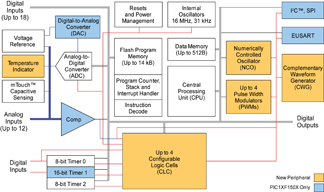 The CLC peripherals on the PIC10F(LF)32X and PIC1XF(LF)150X MCUs enable software control of combinational and sequential logic, which increases the on-chip interconnection of peripherals and I/Os, thereby reducing external components, saving code space and adding functionality. The CWG peripheral works with multiple peripherals to generate complementary waveforms with dead-band control and auto shutdown, which provides improved switching efficiencies. Additionally, the NCO peripheral enables linear frequency control and high resolution, which is required for applications such as lighting ballast, tone generation and other resonant control circuits. The MCUs also feature low power consumption, with currents of less than 30 µA/MHz in active mode, and less than 20 nA in sleep; as well as an on-chip 16 MHz internal oscillator, Analog-to-Digital Converter (ADC), and up to 4 Pulse-Width Modulation peripherals. An integrated temperature-indicator module enables low-cost temperature measurements. The CLC peripherals on the PIC10F(LF)32X and PIC1XF(LF)150X MCUs enable software control of combinational and sequential logic, which increases the on-chip interconnection of peripherals and I/Os, thereby reducing external components, saving code space and adding functionality. The CWG peripheral works with multiple peripherals to generate complementary waveforms with dead-band control and auto shutdown, which provides improved switching efficiencies. Additionally, the NCO peripheral enables linear frequency control and high resolution, which is required for applications such as lighting ballast, tone generation and other resonant control circuits. The MCUs also feature low power consumption, with currents of less than 30 µA/MHz in active mode, and less than 20 nA in sleep; as well as an on-chip 16 MHz internal oscillator, Analog-to-Digital Converter (ADC), and up to 4 Pulse-Width Modulation peripherals. An integrated temperature-indicator module enables low-cost temperature measurements.
To facilitate application development, the PICDEM Lab Development Kit (part # DM163045, $134.99) now includes samples of both the PIC10F322 and PIC16F1507 MCUs. Additionally, the F1 Evaluation Platform (part # DM164130-1, $39.99) is available for development with enhanced mid-range core 8-bit PIC MCUs, including the PIC1XF(LF)150X family. Also available is a free CLC Configuration Tool, to streamline the setup process of the CLC module by simulating the functionality of the registers and combinational logic in a graphical user interface (GUI).
The PIC10F(LF)320 and PIC10F(LF)322 MCUs are available in a 6-pin SOT-23 package, as well as 8-pin PDIP and 2 mm x 3 mm DFN packages. The PIC12F(LF)1501 MCU will be available in 8-pin PDIP, SOIC, MSOP and 2 mm x 3 mm DFN packages, and the PIC16F(LF)1503 MCU in 14-pin PDIP, SOIC and TSSOP packages, as well as a 3 mm x 3 mm QFN package. The PIC16F(LF)1507 MCU is available in 20-pin SSOP, PDIP, SOIC, and 4 mm x 4 mm QFN packages, as will the PIC16F(LF)1508/9 MCUs, when available. Pricing starts at $0.37 each, in 10,000-unit quantities.
Click here for more information.
|
 |
 |
| |
New Products |
| |
Cabot Launches Performance Additive for Advanced Lead-Acid Batteries
Cabot Corp. has launched the PBX51 carbon performance additive that is designed to improve lifetime and performance for lead-acid batteries in micro-hybrid vehicles. Cabot’s new additive is designed to help micro-hybrid manufacturers solve a major barrier to mass market adoption, which is to enable longer lasting, smaller battery performance at a lower cost.
In 2011, automakers sold an estimated 5 million micro-hybrids worldwide. By 2017, this number is expected to grow to 39 million vehicles, representing a market of $6.9 billion in sales, according to a report by Lux Research.
“With the launch of the new PBX51 product, Cabot is helping to accelerate micro-hybrid technology by enabling car battery manufacturers to significantly improve battery performance while lowering costs,” said Fred von Gottberg, vice president and general manager, Cabot New Business Segment. “Our new PBX performance additive further illustrates Cabot’s commitment to applying our passion for innovation and new technologies to solve important problems for our customers.”
Micro-hybrids, which commonly add “start-stop” technologies to conventional gasoline engines, are a fast-growing class of energy-efficient vehicles. Micro-hybrids create a 5 to 15 percent fuel savings advantage over conventional vehicles by shutting down the engine during temporary stops, such as at a traffic light. While the engine is off, the vehicle’s other systems are kept running through the battery, which is recharged by a combination of energy captured during braking and from the engine.
A conventional car battery may see only a few charge-discharge cycles a day, whereas a start-stop battery must withstand dozens. To compensate, micro-hybrid manufacturers typically double the size of the battery and use the more robust valve regulated lead-acid (VRLA) battery design. This approach solves the cycling issue, but adds more weight, cost and space requirements to the vehicle, all of which are detrimental to creating smaller, fuel-efficient cars.
Cabot’s PBX51 performance additive is designed to enable new automobile batteries to last as long under start-stop conditions as conventional car batteries, without today’s several-fold increase in cost and size. In addition, when added to VRLA batteries for micro-hybrids, the PBX51 performance additive has been shown to dramatically improve battery lifetime and the ability to recharge using braking energy. It also prolongs battery life by reducing negative plate sulfation – the major cause of short battery lifetimes in micro-hybrids.
Eltek Ramps Up Battery Distribution Fuse Bay to 4,800 A Total Current Capacity
Eltek has ramped up its -48 VDC battery distribution fuse bay (BDFB)/battery distribution circuit breaker bay (BDCBB) with an 800 amps of power per bus and a total current capacity of 4,800 A. This ensures an uninterrupted power supply for large telecom network central offices and wireless mobile telephone switching offices (MTSOs).
Telecommunications equipment requires power redundancy from the battery plant, and the BDFB/BDCBB provides a variety of load busses and fuse options to meet redundancy requirements. The unit can be configured as a single bus bay or equipped with up to six separate load busses. Both fuses and circuit breakers are accommodated.
Additional flexibility has been added with flexible support for either fuses and/or circuit breaker distribution that utilizes TPS/TLS-style fuses up to 125 amps and/or plug-in bullet-style breakers up to 250 amps.
The BDFB/BDCBB is equipped with Eltek’s Smartpack2 controller, which displays system load voltage and current on each bus and provides extensive programming and monitoring capabilities that enable custom alarm threshold values, alarm grouping and more via both remote and local access.
An optional alarm battery supply (ABS) is included, which provides continued alarm and controller access in the event of power loss. The ABS features redundant alarming, so power is continuously supplied to the alarm circuits until the last bus no longer has power available. An audible alarm is provided with a user-configurable on/off feature.
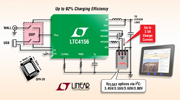 15W I²C Power Manager Charges LiFePO4 Cells at 3.5 A for High Power Density Portable and Battery Back-up Systems 15W I²C Power Manager Charges LiFePO4 Cells at 3.5 A for High Power Density Portable and Battery Back-up Systems
Linear Technology Corp. has introduced the LTC4156, a high power, I²C controlled, PowerPath manager, diode controller and Lithium Iron Phosphate (LiFePO4) battery charger for single-cell devices such as portable medical and industrial devices, backup devices and other high power density battery-powered applications. The IC is designed to efficiently transfer up to 15 W from a variety of sources while minimizing power dissipation and easing thermal constraints. The LTC4156’s switching PowerPath topology manages power distribution from two input sources such as a wall adapter and USB port to the device’s rechargeable LiFePO4 battery while preferentially providing power to the system load when input power is limited.
Because power is conserved, the LTC4156 allows the output load current to exceed the current drawn by the input supply, maximizing use of the available power for battery charging without exceeding the input supply power delivery specifications. For example, when powered from a 5 V/2 A wall adapter, the IC’s switching regulator efficiently transfers more than 90 percent of the available 10 W, enabling up to 2.4 A charge current for faster charge times. Unlike ordinary switching battery chargers, the LTC4156 features instant-on operation to ensure that system power is available at plug-in even with a deeply discharged battery. USB OTG (On-the-Go) support provides a 5 V supply back to the USB port without any additional components.
A simple 2-wire I²C port provides broad adjustability for many system control parameters including charge current, input current and float voltage. The communications bus also allows the LTC4156 to provide status information such as battery temperature, input supply status, charger status and fault status.
The LTC4156’s autonomous full-featured single-cell LiFePO4 battery charger is capable of up to 3.5 A charge current with fifteen charge current settings. The charger includes automatic recharge, bad cell detection, programmable safety timer, thermistor temperature qualified charging, programmable end-of-charge indication/termination and programmable interrupt generation.
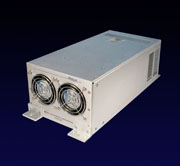 2 kW/600 VDC Industrial Grade PFC-Input Battery Charger 2 kW/600 VDC Industrial Grade PFC-Input Battery Charger
Absopulse Electronics’ BCP 2K-E/600 series of rugged, industrial grade battery chargers with PFC-input provide 2 kW continuous power for charging a 600 V external battery bank. These chargers are suitable for installation on electric vehicles.
The units are available with input ranges of either 190 V to 264 VAC or 90 V to 264 VAC, with versions of this design capable of charging battery banks from power outlets in almost any country in the world are therefore available. Several BCP 2K-E/600 units may be parallel connected to achieve higher output power and reduce the time required to recharge the battery bank. The 600 VDC output is adjustable 520 V to 630 V by user accessible trimming potentiometers.
The chargers have full ruggedizing and conformal coating for immunity to shock, vibration, humidity, moisture and airborne contaminants, essential for demanding road conditions. They meet EN/IEC61373 Cat 1 A&B shock and vibration standards. The modules comply with EN/UL60950 and equivalent industrial safety standards as well as the EN61000-3-2 and EN61000-3-12 directives for low input harmonic distortion. They are filtered to meet EN55022-A EMI standards with large margins, minimizing impact on on-board electrical systems.
The BCP 2K-E/600 is housed in a ruggedly constructed 187 mm by 132 mm by 407 mm chassis-mount enclosure. High grade internal fans provide sufficient airflow for operation over a 0°C to 50°C temperature range for full specification; wider temperature ranges are available.
Exide Technologies Introduces Extreme Power 1000
Exide Technologies has launched the newest heavy duty battery to join its portfolio, the Extreme Power 1000, designed to meet the ever increasing demands of the heavy-duty aftermarket. With greater starting power and three times the vibration resistance of traditional flooded batteries, the Extreme Power 1000 delivers 1,000 CCA (cold cranking amps) and 200 RC (reserve capacity) minutes. It meets the challenge when its time to start and time to haul due to Exide’s patented silver alloy cast positive grids, double insulated glass mat lined separator envelopes, Stabl-Lok Plus epoxy anchor bonding and reinforced case and cover with an easy to carry handle. It is backed by a 24-month free replacement nationwide warranty.
TE Circuit Protection’s MHP Technology Now Offers Smart Activation Feature
TE Circuit Protection has announced a Metal Hybrid PPTC (MHP) device offering Smart Activation (SA) functionality. The MHP-SA device provides a resettable, cost-effective and space-saving alternative to typical methods of protecting high-power lithium battery and module applications. These include cordless power tools, e-scooters and light electric vehicles (LEVs) and standby power and energy storage systems (ESSs).
The MHP-SA device helps provide overcharge protection in large multi-cell battery packs and modules in which circuit protection devices interface with electronics as part of a sophisticated battery management system. The MHP-SA device’s Smart Activation design feature accomplishes this via a third terminal signal line that enables external activation.
In a typical scenario, an IC monitors the battery system’s temperature, current and voltage and, if an abnormality is detected, it switches on a FET and activates the heater element (PPTC) of the MHP-SA device to heat the bimetal. The bimetal contacts then open and cut contact to the main line. The first in a series of planned devices, the new MHP-SA50-400-M5 device has a 50A/400VDC maximum rating and its hold current is 50 A on the main line. The device can be activated electronically with as little as 3 A via the signal line.
MHP Technology utilizes a hybrid circuit protection approach, combining a bimetal protector in parallel with a polymeric positive temperature coefficient (PPTC) device. Resettable MHP technology offers excellent arc suppression characteristics and also offers a smaller size and thinner form factor compared to larger DC fuses or other protection devices.
The MHP-SA device helps save design costs due to its ability to employ a low-power switch to open the main line, enabling lower-cost FETs to be installed. And because the MHP-SA device is resettable there is no need to overrate for inrush currents. In some cases, designers can replace larger, higher-cost DC fuses with an MHP-SA device.
|
| |
Industry News |
| |
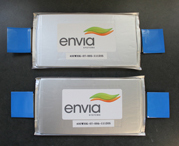 Envia Systems Achieves World Record Energy Density for Rechargeable Lithium-Ion Batteries Envia Systems Achieves World Record Energy Density for Rechargeable Lithium-Ion Batteries
Envia Systems has released test results that verify the company’s next-generation rechargeable battery has achieved the highest recorded energy density of 400 Watt-hours/kilogram (Wh/kg) for a rechargeable lithium-ion cell. When commercialized, this 400 Wh/kg battery is expected to reduce the price of a 300-mile range electric vehicle by cutting the cost of the battery pack by more than 50 percent.
The testing of Envia’s next-generation lithium-ion battery was performed by the Electrochemical Power Systems Department at the Naval Surface Warfare Center (NSWC) in Crane, Ind., under the sponsorship of ARPA-E. Tests at various cycling rates at NSWC confirmed that Envia’s automotive battery cell demonstrated energy density between 378 to 418 Wh/kg for rates between C/3 to C/10 for a 45 Amp-hour (C/3) cell. Similar cells have been cycling in Envia’s test labs for more than300 cycles. NSWC Crane will also test these cells to validate cycling performance.
“Since the inception of Envia, our product team has worked tirelessly and logged over 25 million test channel hours to optimally develop each of the active components of the battery: Envia's proprietary Si-C anode, HCMR cathode and EHV electrolyte," said Dr. Sujeet Kumar, Envia Systems co-founder, president and CTO. “Rather than just a proof-of-concept of energy density, I am pleased that our team was successful in actually delivering 400 Wh/kg automotive grade 45 Ah lithium-ion rechargeable cells.”
West Coast Electric Highway Helps Kick the Gas Habit with First Electric Vehicle Fast-Charging Stations Along Interstate 5
The Oregon Department of Transportation (ODOT), along with charging station partner AeroVironment and the Oregon Department of Energy (ODOE), opened the first phase of the West Coast Electric Highway, which is anticipated to eventually stretch along Interstate 5 from the Canadian to Mexican borders. The charging station hubs introduced will provide electric vehicle (EV) owners access to a network of electric “refueling” stations along a major transportation artery in southern Oregon.
“As the first state in the nation to establish an EV charging infrastructure along a major interstate, Oregon is leading the EV pathway and supporting adoption of the next phase in the evolution of transportation,” said Pat Egan, chair of the Oregon Transportation Commission and vice president of customer and community affairs for Pacific Power. “Once Oregon’s segment of the West Coast Electric Highway is completed, EV drivers will be able to travel from Ashland to Portland at a fraction of the cost of filling a gas tank and with no direct emissions.”
The West Coast Electric Highway will eventually allow EV drivers to travel from San Diego to Vancouver, B.C. without relying on carbon-based fuel. “Fast” charging stations, included at each of the newly operational locations, can provide a full charge for an EV in less than 30 minutes; soon, these stations will dot interchanges up and down I-5.
Spaced at roughly 25-mile intervals along the southern Oregon I-5, the AeroVironment charging stations are available at convenient locations in Cottage Grove, Rice Hill, Roseburg, Canyonville, Wolf Creek, Grants Pass, Central Point and Ashland. Each location has two charging stations including one DC “fast” charger. Plans call for more than 40 additional charging stations from AeroVironment to be operational in Oregon and Washington by the end of the year.
ODOE awarded ODOT $915,000 in American Recovery and Reinvestment Act funding through ODOE’s State Energy Program to install the network of EV charging stations.
Siemens Supplies Solutions for Electric Vehicle Charging to Veterans Affairs Facilities
Siemens is one of the first companies awarded a General Services Administration (GSA) Schedule 56 contract to provide Electric Vehicle (EV) charging stations to the US Government. A total of 20 Siemens EV charging stations will be deployed to Veterans Affairs facilities in California and Michigan by the EV Infrastructure business of the Siemens Infrastructure & Cities sector. The EV charging station on the GSA Schedule is the Community Level II designed for public outdoor applications.
Siemens' charging stations offer cloud-based EV charging services via the ChargePoint Network, the largest network of independently owned charging stations in the world. ChargePoint Network is used by organizations that want to attract large numbers of EV drivers to their charging stations, manage their charging services, set up fees, automate payment processing and collect and track charging data. Drivers use ChargePoint Network and its three mobile apps for iPhone, Android and Blackberry to: find charging stations, see if a station is available or in use, get turn-by-turn directions, check station pricing and even make station reservations.
The US government operates the largest vehicle fleet in the country. Over the past two years, GSA has doubled the Federal hybrid fleet without increasing the total number of vehicles. The resulting improvement in fleet fuel efficiency is expected to annually save almost 2,900 gallons of gas, reduce greenhouse gas emissions by 275 metric tons and save taxpayers almost $116,000 in fuel costs.
|
| |

|
 |
Event Listings |
 |
 |
 Battery Power 2012 - Call for Presentations Battery Power 2012 - Call for Presentations
Battery Power 2012 is currently accepting abstracts for its tenth annual event, September 18-19 in Denver, Colorado. The international event will explore the important topics impacting battery power technology from design issues in battery packs and emerging charging technologies to predicting battery failure and battery hybrid systems. Other topics include cell design and manufacturing, power management, testing, materials, market trends and end-user requirements for new applications. Presentations will cover the portable/mobile, automotive/EV and stationary/onsite power markets.
The Call for Presentations deadline is April 12.
With more than 400 attendees, the conference provides an excellent forum to discuss new developments in technology, market conditions and end-user requirements that are driving innovation, capabilities and features, application trends and performance improvements. Attendees include top executives, technical managers and engineering professionals from original equipment manufacturers, system developers and integrators, dealers and component providers.
|
 |
 |
|
 |
 |
 SAE 2012 Powertrain Electric Motors Symposium for Electric & Hybrid Vehicles SAE 2012 Powertrain Electric Motors Symposium for Electric & Hybrid Vehicles
April 23
Detroit, Mich.
Join technology leaders at the SAE 2012 Powertrain Electric Motors Symposium for Electric & Hybrid Vehicles, on April 23 in Detroit, Michigan. This one-day symposium promises to provide a comprehensive overview on the latest global innovations in the vehicle powertrain electric traction motor industry. It will give insight on how fast the major players are moving and how this affects the world marketplace. The program will address market growth projections, requirements, and cost structures for three varieties of electric traction motors: permanent magnet motors, induction motors, and switch reluctance motors. This year's symposium will feature expanded coverage of rare earth metals, and, for the first time, presentations on testing and simulation.
 SAE 2012 WORLD CONGRESS SAE 2012 WORLD CONGRESS
April 24-26
Detroit, Mich.
The SAE 2012 World Congress theme, Get Connected, represents the new and diverse connections that will drive significant advancements in the auto industry of tomorrow. Not only does the theme symbolize literal connections, such as those between vehicles, infrastructure, the Internet, and the nation's electrical grid, but also demonstrates the most fundamental of connections; the connections and relationships between engineers who are developing the next generation vehicle technology. A must-attend for the automotive engineering community, this event represents an unparalleled opportunity to explore new technology through both technical sessions and the Innovators Only Exhibition.
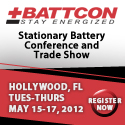 Battcon Stationary Battery Conference Battcon Stationary Battery Conference
May 15-17
Hollywood, Fla.
The 16th Annual Battcon Stationary Battery Conference and Trade Show is a three day, technically oriented event where battery professionals learn more about batteries, trends, and technology at the Westin South Florida. Noncommercial presentations address battery applications, advances, and industry concerns. Battcon offers presentations, discussions, workshops, and a trade show.
Visit www.battcon.com
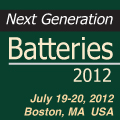 Next Generation Batteries 2012 Next Generation Batteries 2012
July 19-20
Boston, Mass.
Next Generation Batteries 2012 on July 19-20, 2012 in Boston, MA will focus on breakthroughs in new battery chemistries, novel electrode and electrolyte materials, system integration for a vast array of mobile, portable and stationary applications, from micro medical devices to high-energy/high-power automotive, have paved the roadmap for an emerging market with unlimited potential. Will lithium-ion batteries deliver on the promises of power, energy, cost and safety in commercially available systems or does the future lay somewhere beyond lithium-based chemistries? Our panel of leading experts in the fields of battery materials, systems design and integration, manufacturing and commercial applications will look into emerging issues underlining this pivotal time in the battery industry segment.
|
 |
| |
Contact Us |
|
| |
Submit editorial content to Shannon Given at 608-351-9245
For advertising information contact Jeremy Fleming at 800-803-9488 X121
Webcom Communications • 7355 E. Orchard Road, Suite 100; Greenwood Village, CO 80111
Phone: 800-803-9488 • Fax: 720-528-3771 • www.infowebcom.com |
|
| |
© 2012 Webcom Communications Corp. |
|
|
|
|
|
|